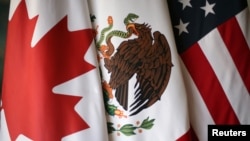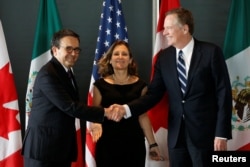A NAFTA termination letter from U.S. President Donald Trump could become the ultimate sleight of hand from Washington as it seeks to gain negotiating leverage over Canada and Mexico in talks to update the 24-year-old trade pact.
While such a letter would start a six-month exit clock ticking, the United States would not be legally bound to quit the North American Free Trade Agreement once it expires.
Unlike the irreversible missile that Britain fired when it triggered a two-year countdown to its exit from the European Union last March, quitting NAFTA would still be optional for Trump. And an exit would almost certainly face court challenges over Trump's authority to leave without consent from Congress.
Quitting NAFTA without quitting
Canadian government sources told Reuters on Wednesday that they are increasingly convinced that Trump will soon announce the U.S. intention to pull out of NAFTA. The news sent Canadian and Mexican currencies lower and hurt stocks across the continent.
Sending a termination letter would allow Trump, who has been frustrated with Mexican and Canadian reluctance to meet aggressive U.S. demands on the sourcing of automotive parts and on dispute settlement, to take a key step toward meeting his campaign promise of quitting NAFTA if it cannot be revised to shrink U.S. trade deficits.
“He can gain political mileage out of a big announcement to quit NAFTA without actually doing it,” said Gary Hufbauer, a senior fellow and trade expert at the Peterson Institute for International Economics who has written extensively on NAFTA termination issues.
“He could say that he'll withdraw from NAFTA sometime after the six-month deadline if we don't get better results in the negotiations,” Hufbauer said.
Two more rounds, then a pause?
Using a withdrawal letter in this manner fits in with a scenario that some industry lobbyists and trade observers say is increasingly likely: If there's no deal after two more scheduled negotiating rounds in late January and March, NAFTA talks would be put on hold for several months as Mexico's presidential election campaign gets under way.
By the time talks resume, the withdrawal threat could have more potency as a negotiating tactic.
NAFTA's Article 2205 states: “A party may withdraw from this agreement six months after it provides written notice of withdrawal to the other parties. If a party withdraws, the agreement shall remain in force for the remaining parties.”
The president would be then free to declare the restoration of U.S. tariffs to levels agreed at the World Trade Organization, although experts say that Canada would revert to the terms of a 1987 U.S. trade agreement that predated NAFTA.
Legal challenges likely
Any move by Trump to invoke this clause is almost certain to be met with immediate legal challenges from U.S. business groups that would argue that congressional consent would be required because the U.S. Constitution grants Congress authority over trade matters.
In recent weeks, Republican lawmakers have been raising increasing concerns about the dangers of quitting NAFTA, particularly in U.S. farm states that count Mexico as their biggest grains customer.
On Wednesday, U.S. Chamber of Commerce President Tom Donohue called quitting NAFTA a “grave mistake” that would send the U.S. economy “five steps back.”
Because implementing legislation would remain on the books, many provisions of NAFTA would still be active, including trade and investment dispute arbitration systems that the Trump administration wants to change.
“I think this is headed for a huge legal morass if the president were to unilaterally send a notice of withdrawal,” Jennifer Hillman, a Georgetown University law professor and former WTO appellate judge, told Reuters in November.












